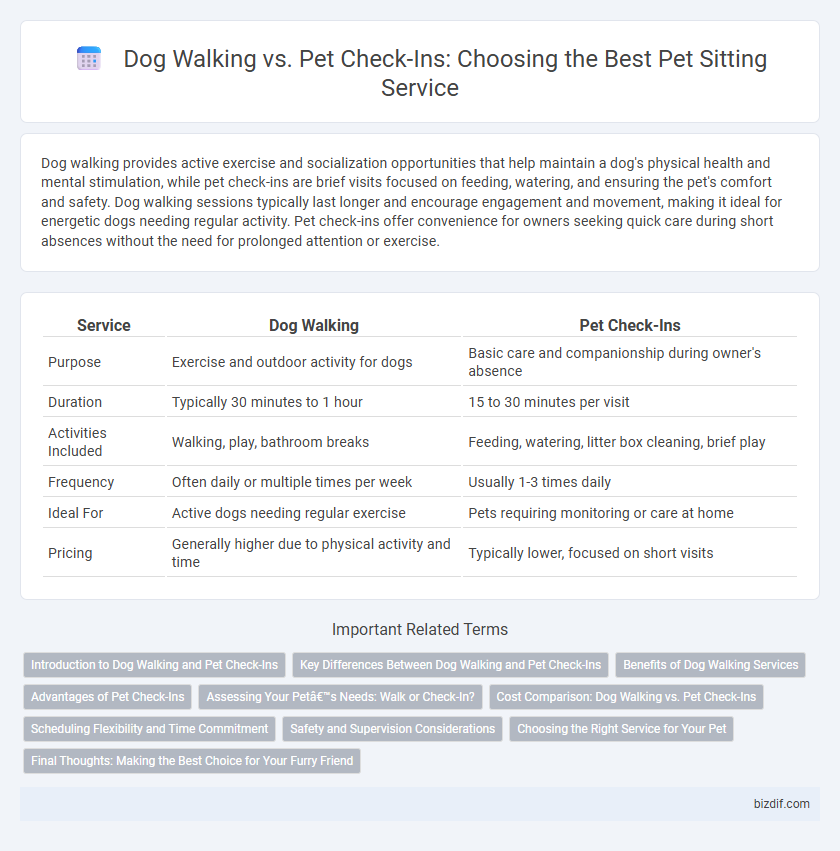Dog walking provides active exercise and socialization opportunities that help maintain a dog's physical health and mental stimulation, while pet check-ins are brief visits focused on feeding, watering, and ensuring the pet's comfort and safety. Dog walking sessions typically last longer and encourage engagement and movement, making it ideal for energetic dogs needing regular activity. Pet check-ins offer convenience for owners seeking quick care during short absences without the need for prolonged attention or exercise.
Table of Comparison
| Service | Dog Walking | Pet Check-Ins |
|---|---|---|
| Purpose | Exercise and outdoor activity for dogs | Basic care and companionship during owner's absence |
| Duration | Typically 30 minutes to 1 hour | 15 to 30 minutes per visit |
| Activities Included | Walking, play, bathroom breaks | Feeding, watering, litter box cleaning, brief play |
| Frequency | Often daily or multiple times per week | Usually 1-3 times daily |
| Ideal For | Active dogs needing regular exercise | Pets requiring monitoring or care at home |
| Pricing | Generally higher due to physical activity and time | Typically lower, focused on short visits |
Introduction to Dog Walking and Pet Check-Ins
Dog walking involves taking dogs on scheduled outdoor walks to ensure exercise, socialization, and mental stimulation, promoting overall canine health and well-being. Pet check-ins focus on brief visits to a pet's home, providing essential care such as feeding, watering, and companionship, ideal for pets requiring minimal activity or owners with busy schedules. Both services cater to different pet needs, balancing physical activity with attentive care.
Key Differences Between Dog Walking and Pet Check-Ins
Dog walking involves taking dogs outside for exercise, socialization, and bathroom breaks, typically lasting from 30 minutes to an hour, while pet check-ins consist of short visits to provide feeding, playtime, and basic care for various pets without extended outdoor activity. Dog walking requires more physical activity and time commitment, focusing primarily on the dog's health and mental stimulation, whereas pet check-ins emphasize monitoring the pet's well-being and maintaining routines within the home environment. Understanding these differences helps pet owners choose services best suited to their pet's needs and lifestyle.
Benefits of Dog Walking Services
Dog walking services provide essential physical exercise that supports a dog's cardiovascular health and weight management. Regular walks also enhance mental stimulation, reducing anxiety and destructive behaviors through exposure to new environments and social interactions. Compared to pet check-ins, dog walking offers more comprehensive care by actively engaging pets in activities that promote their overall well-being.
Advantages of Pet Check-Ins
Pet check-ins offer personalized, stress-free care by allowing pets to stay in their familiar home environment, reducing anxiety often caused by stressful outings. These visits include feeding, playtime, and administering medication, ensuring comprehensive attention tailored to a pet's specific needs. Compared to dog walking, pet check-ins provide a broader range of care services, making them ideal for pets requiring closer supervision or multiple daily care sessions.
Assessing Your Pet’s Needs: Walk or Check-In?
Assessing your pet's needs involves understanding their activity level, temperament, and health requirements to determine whether dog walking or pet check-ins are more suitable. Dogs with high energy and social needs benefit from daily walks that provide exercise and mental stimulation, while pets with mobility issues or anxiety may respond better to brief, calm check-ins focused on feeding and companionship. Tailoring services to your pet's unique behavior and well-being ensures optimal care and happiness.
Cost Comparison: Dog Walking vs. Pet Check-Ins
Dog walking services typically range from $15 to $30 per 30-minute walk, reflecting the active engagement and exercise provided. Pet check-ins usually cost between $20 and $35 for a 20 to 30-minute visit, encompassing feeding, hydration, and basic care. Choosing between dog walking and pet check-ins depends on budget and the pet's specific needs for exercise versus companionship and care.
Scheduling Flexibility and Time Commitment
Dog walking offers scheduled sessions, typically lasting 30 to 60 minutes, providing consistent exercise and mental stimulation for dogs at specific times of the day. Pet check-ins are more flexible, allowing pet sitters to visit multiple times daily for shorter periods, such as 15 to 30 minutes, ideal for feeding, medication administration, and companionship without a long time commitment. Scheduling flexibility is higher with pet check-ins, accommodating varying owner schedules, while dog walking requires fixed appointments to ensure regular physical activity for the dog.
Safety and Supervision Considerations
Dog walking provides active exercise and socialization but requires vigilant supervision to ensure the dog's safety in outdoor environments, avoiding hazards like traffic and other animals. Pet check-ins offer a controlled setting for monitoring pets' health, feeding, and comfort without the risks associated with outdoor walks. Choosing between the two depends on the pet's behavior, health needs, and the sitter's ability to maintain strict safety protocols in varied settings.
Choosing the Right Service for Your Pet
Dog walking provides structured exercise and socialization tailored to your dog's energy levels and breed, promoting physical health and mental stimulation. Pet check-ins offer personalized care focused on feeding, hydration, and companionship during your absence, ideal for pets requiring less activity or with special needs. Selecting the appropriate service depends on your pet's activity requirements, temperament, and your schedule to ensure their well-being and happiness.
Final Thoughts: Making the Best Choice for Your Furry Friend
Choosing between dog walking and pet check-ins depends on your pet's exercise needs and companionship preferences. Dog walking provides essential physical activity and socialization for energetic dogs, while pet check-ins offer brief visits to ensure feeding, hydration, and comfort for pets requiring less activity. Prioritizing your dog's health, routine, and temperament ensures the best personalized care and overall well-being.
Dog walking vs Pet check-ins Infographic

 bizdif.com
bizdif.com